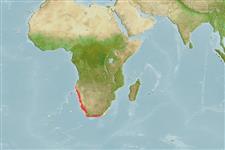Holocéphales (chimères) (chimaeras) >
Chimaeriformes (Chimaeras) >
Callorhinchidae (Plownose chimaeras)
Etymology: Callorhinchus: Tautonymous with Chimaera callorynchus Linnaeus 1758 (but unnecessarily emended from -rynchus to -rhinchus: callum (L.), hard skin; rhynchus (L.), snout, referring to peculiar hoe-shaped proboscis. (See ETYFish); capensis: -ensis, Latin suffix denoting place: Cape of Good Hope, type locality. (See ETYFish).
More on author: Duméril.
Environment: milieu / climate zone / depth range / distribution range
Écologie
marin démersal; profondeur 10 - 374 m (Ref. 5578), usually 10 - 200 m (Ref. 3180). Subtropical; 17°S - 35°S, 11°E - 34°E
Southeast Atlantic: Namibia to the Cape and Natal in South Africa (Ref. 5578, 58304).
Length at first maturity / Taille / Poids / Âge
Maturity: Lm 49.6 range ? - ? cm
Max length : 122 cm TL mâle / non sexé; (Ref. 3180); poids max. publié: 5.3 kg (Ref. 40637)
Description synthétique
Morphologie | Morphométrie
Épines dorsales (Total): 1. An elephant fish with a hoe-like snout and arched caudal fin (Ref. 5578). Silvery or bronzy with brown markings on flanks and head; fin webs brown (Ref. 5578).
Found from close inshore and shallow bays to the slope (Ref. 5578). Feeds on small fish and a wide variety of invertebrates (Ref. 27121). Oviparous (Ref. 50449). Produces egg-cases that are spindle shaped, with broad horizontal flanges (Ref. 36731). This species is known to host on its gills monogenean parasites Callorhynchocotyle callorhynchi (Manter, 1955) (Hexabothriidae) and Callorhynchicola multitesticulatus Manter, 1955 (Chimaericolidae) on its gills (Ref. 124045, 124046). Sold commercially as 'silver trumpeter' (Ref. 3180) and considered a delicacy in southern Africa (Ref. 27121). Minimum depth reported from Ref. 7403.
Life cycle and mating behavior
Maturité | Reproduction | Frai | Œufs | Fécondité | Larves
Krefft, G., 1990. Callorynchidae. p. 117. In J.C. Quero, J.C. Hureau, C. Karrer, A. Post and L. Saldanha (eds.) Check-list of the fishes of the eastern tropical Atlantic (CLOFETA). JNICT, Lisbon; SEI, Paris; and UNESCO, Parisl. Vol. 1. (Ref. 7403)
Statut dans la liste rouge de l'IUCN (Ref. 130435)
Menace pour l'homme
Traumatogenic (Ref. 12484)
Utilisations par l'homme
Pêcheries: intérêt commercial mineur; pêche sportive: oui
Plus d'informations
RéférencesAquacultureProfil d'aquacultureSouchesGénétiqueElectrophoresesHéritabilitéPathologiesTraitementNutrientsMass conversion
CollaborateursImagesStamps, Coins Misc.SonsCiguateraVitesseType de nageSurface branchialeOtolithesCerveauxVision
Outils
Articles particuliers
Télécharger en XML
Sources Internet
Estimates based on models
Preferred temperature (Ref.
123201): 10.3 - 21, mean 16.2 °C (based on 200 cells).
Phylogenetic diversity index (Ref.
82804): PD
50 = 0.7500 [Uniqueness, from 0.5 = low to 2.0 = high].
Bayesian length-weight: a=0.00437 (0.00175 - 0.01086), b=3.12 (2.90 - 3.34), in cm total length, based on LWR estimates for this (Sub)family-body shape (Ref.
93245).
Niveau trophique (Ref.
69278): 3.5 ±0.52 se; based on food items.
Generation time: 21.3 ( na - na) years. Estimated as median ln(3)/K based on 2
growth studies.
Résilience (Ref.
120179): Faible, temps minimum de doublement de population : 4,5 à 14 années (Fec assumed to be <100).
Fishing Vulnerability (Ref.
59153): High vulnerability (59 of 100).
Climate Vulnerability (Ref.
125649): Moderate to high vulnerability (50 of 100).
Nutrients (Ref.
124155): Calcium = 27.3 [7.3, 78.0] mg/100g; Iron = 0.819 [0.288, 3.576] mg/100g; Protein = 14.1 [11.0, 18.4] %; Omega3 = 0.255 [0.106, 0.572] g/100g; Selenium = 38.9 [8.7, 103.3] μg/100g; VitaminA = 6.42 [2.18, 18.02] μg/100g; Zinc = 0.549 [0.281, 1.037] mg/100g (wet weight);
